Roman baths of Forum Traiani
- Roman Age, I-VI century A.D.
The centre of Forum Traiani (figs. 1-2) is in an ideal geographical position along the internal penetration route created by the Tirso valley. It thus becomes an outpost of the Roman island part towards the rugged, mountainous centre of the island.

Undoubtedly, the presence of the naturally hot thermal waters spring was one of the factors contributing to the birth of the first settlement. It was elevated to the dignity of forum by the emperor Trajan, as the name clearly indicates.
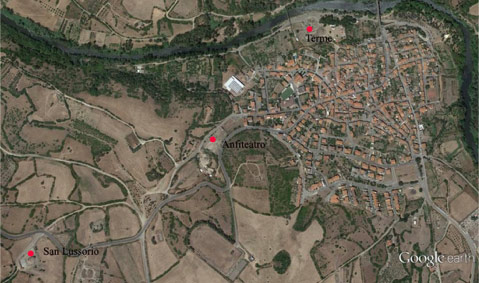
Even before that the small centre was important. It is not by chance that it was where they found an inscription in which the civitates Barbariae (fig. 3), that is the tribes living in the inner parts of the island and not subject to Roman dominion, submitted to the emperor Tiberius, just after 19 A.D. This is fundamental evidence to reconstruct the picture of a now pacified Sardinia where the internal communities, maintaining their own political and social organisation, lived together with the vaster zones governed directly by Rome.
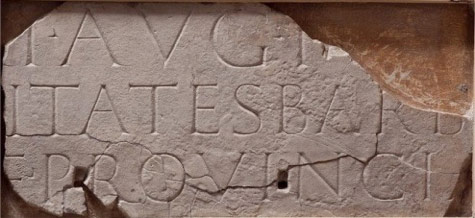
The site's importance is confirmed by a series of dedicated inscriptions documenting the presence, albeit occasional, of the governor of the island and other magistrates.
Recent digs are bringing to light an amphitheatre (fig. 4), structure usually linked to more important centres. Till now, amphitheatres were only known of in Sardinia at Cagliari, Nora, Sant’Antioco and Tharros.
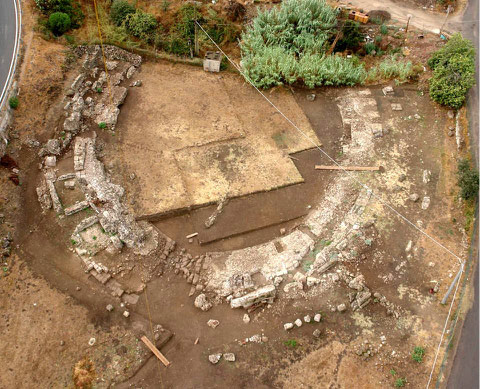
Numerous inscriptions found in the Baths area dedicated to the Nymphs are closely linked to the waters; other inscriptions, a smaller number, are dedicated to the healthy god, Asclepius. The value of the healthy water cult is recognised with the inclusion of a specific divinity , like Asclepius, expressed in two small statues representing the god Bes/Asclepius coming from the Baths area (fig. 5).
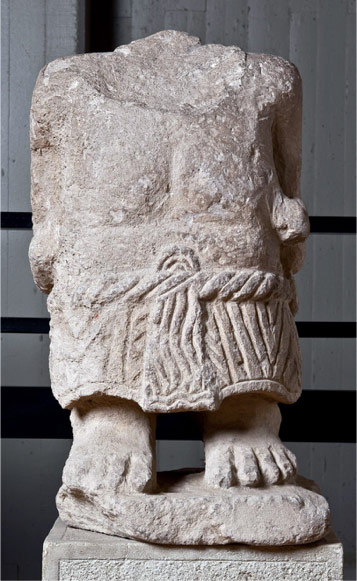
Fordongianus is then known as place of the martyrdom of San Lussorio, on the supposed site on which a small church was erected by Vittorini of Marseille at the start of the XII century, probably on the remains of an early Christian church building, of which the foundations remain. The crypt, under the holy structure, preserves burials and mosaic fragments (fig. 6) enabling it to be dated IV century A.D., an age consistent with the period of the Saint's martyrdom in the Diocletian era.
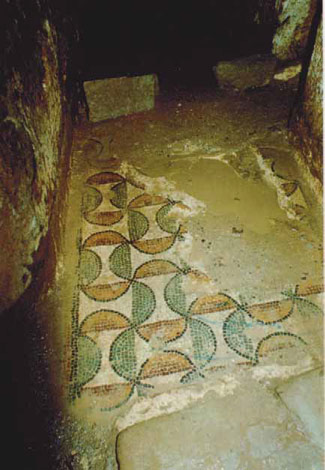
The Baths building is in the immediate vicinity of the Tirso river. In fact, there are two buildings: Baths I and Baths II, following each other in time, but integrated. Many construction stages and uses have been recognised, not entirely clear, from when the digs took place at the start of the last century without preserving the memory of the different stages.
Baths I (fig. 7).

The date proposed for the first building stage of the baths building is the Trajan period, at the start of the II cent. A.D., based on comparisons for the building technique used and the type of rooms, but there is no sure stratigraphic data as yet. The baths exploited the naturally hot water which flows at a temperature of about 54 degrees. It is in the northern part of the area. The central nucleus started with the large natatio A (fig. 8) (12.20x6.10m, 1.60m deep), a pool surrounded by four steps which received the hot water mixed with cold. The pool is built from local ash-grey, trachyte blocks using the opus quadratum head and cut technique, technique used in most of Baths I.

The pool had two long sides, north and south, two porticoes, with five openings towards the pool delineated by squared pillars, vaulted in opus caementicium with ribbing in opus quadratum. Lighting was ensured by skylights in the vaults, of which three remain. The southern portico is the only one left; we can see its length of 16.60m and a width of 1.80m and a height of 3.90m, but the other's presence is sure. In fact, you can see the bases on pillars on the northern side of the pool, and its existence is the static condition for creating the roof over the large natatio, which we can suppose was a large cross vault.
On the western side of the pool you have the rectangular B environment which extends to the South, just past the mighty wall delimiting the portico. It was connected to the pool by a door of which you can still see jambs and threshold; you can also see the canals carrying the hot waters to the pool, in which they flowed out of an animal protome (fig. 9) datable to a very late stage of the baths plant, after being suitably tempered in a specific tank. At the northern end of the B environment there is a small semi-circular bath, probably used for hot water baths.

Immediately west of B, there are two service basins/ tanks: C and D. The first collected the hot thermal waters and transferred them to D where they were mixed with cold water to be channelled to the pool. These two basins were subjected to several works and renovation during the life of the baths.
On the short side opposite the pool, the eastern one, there is another rectangular environment, called B1. This is of particular importance because the dig enabled it to be identified as a nymphaeum (fig. 10). The wall is structured in niches, in one of these they found in situ an inscription dedicated to the Nymphs, placed there by a high Roman official. The other niches were found empty, but probably held dedications or ornamental statues.

That the nymphs were worshipped in Fordongianus was already known through a series of dedicatory inscriptions; but now having found the nymphaeum also indicates where the fulcrum of the cult was. Fordongianus was also where they worshipped Asclepius, healthy divinity, obviously linked to the beneficial effects of the bath waters. We have not only dedicatory inscriptions but also small statues reproducing the god Bes, beneficial, healthy figure often compared to Asclepius, boasting an ancient cult tradition in Sardinia from the Punic era.
In a second stage, hypothesised as at least the III cent. A.D. considering the building technique used, the Baths building was considerably increased towards the South, with the addition of new spaces. This stage is called Baths II.
Baths II (fig. 11)
The new building follows the planimetric- altimetric trend of the natural land, which climbs from the banks of the river Tirso, so is at a level higher than Baths I, and is closely connected with a very important building stage, the birth of the central public nucleus of Forum Traiani.

In the eastern sector of this new part you can see room I, quadrangular in shape, recognisable as frigidarium from the presence of two baths opposite each other on the South and North sides of the room: the first semi-circular and the other rectangular. At the south-eastern end of I you have a small room, H, whose function is not currently known. On the southern side, the frigidarium I had a large threshold, already blocked in ancient times (fig. 12) which led to a large room, R, where only the foundations are left, structurally connected to the paved floor of the rear forum, which was probably the atrium of the Baths building.
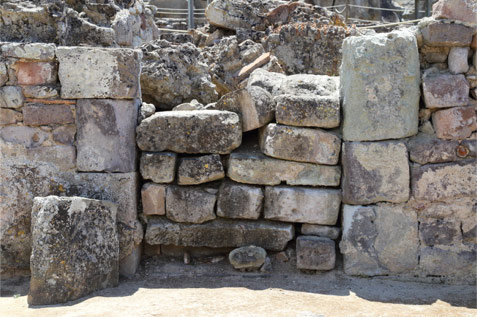
Moving to the West we have room L, recognisable as a tepidarium due to both the wall cavity through which the hot air travelled, and for its position between the frigidarium and the two adjacent inter-communicating calidaria: N and O. The first is bigger with a rectangular bath; the other is smaller and stands on the wall in opus quadratum of Baths I. Immediately to the North of room L, adjacent to O, you have the small room M, with a visible late, modest staircase connecting Baths II with Baths I. Sadly, we cannot know all the transformations that took place in this room before the stairs were built, for which a clue can be found in the praefurnium. Therefore, we still have the problem of circulation between Baths I and Baths II during the period when the baths complex developed most in the full imperial period.
Still further West, Baths II ends with two small rooms, P and Q, recognised as furnaces used to heat the rooms.
Immediately South of the Baths you have a large paved square (figs. 13-14), crossed by water canals, with, in its southern part, a badly preserved staircase leading towards the modern habitat; in its upper part you can still see the remains of water cisterns and tanks. The supposition is that this square was the town forum which, in its upper part, had a temple building, but there is no proof.


The eastern part of the area holds a single L-shaped building, with two corridors overlooking a large openair space adjacent to the atrium of Baths II. Several small rooms open on these corridors, still to be surveyed in full. The few dig reports have highlighted the good level of these rooms which, at least in one case, have walls frescoed with decorations datable to during the III cent. A.D. (fig. 15).
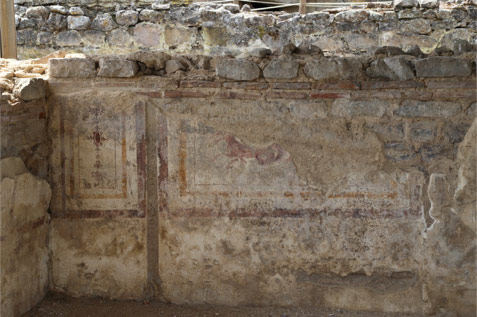
The function of this building for which extension and structure are still unknown, is not clear: it could be a macellum, market place, or a hospitium, a sort of hotel for Baths visitors.
Bibliografia
- ANGIOLILLO S., Mosaici antichi in Italia, Sardinia, Roma, 1981, pp. 155-56.
- BACCO G.-SERRA P.B., Forum Traiani: il complesso termale e l’indagine archeologica di scavo, in L’Africa Romana XII, Atti del Convegno di Studio 1996, pp. 1213-1255.
- SOTGIU G., Iscrizioni latine della Sardegna I, Padova 1961, nn. 186-206.
- SOTGIU G., Arula dedicata ad Esculapio da un L.Cornelius Sylla (Fordongianus, Forum Traiani), in AA.VV., Studi in onore di Giovanni Lilliu per il suo settantesimo compleanno, Cagliari 1985, pp. 117-124.
- SPANO G., Descrizione di Forum Trajani, BAS, VI, 1860, pp. 161-170.
- TARAMELLI A., Fordongianus. Antiche terme di Forum Trajani, NS, 1903, pp. 469-492.
- ZUCCA R., Fordongianus, Sassari 1986.
- ZUCCA R., Le iscrizioni latine del Martyrium di Luxurius: (Forum Traiani, Sardinia), Oristano 1988.
- ZUCCA R., Civitas Forotraianensis, in A. Mastino (ed.), Storia della Sardegna antica, Sassari 2005, pp. 295-301.
- ZUCCA R., Forum Trajani e la Sardinia romana, s.l. 2008.

 VR
VR